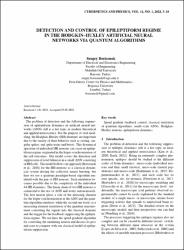| dc.contributor.author | Borisenok, Sergey | |
| dc.date.accessioned | 2022-07-21T08:52:15Z | |
| dc.date.available | 2022-07-21T08:52:15Z | |
| dc.date.issued | 2022 | en_US |
| dc.identifier.uri | https://doi.org/10.35470/2226-4116-2022-11-1-7-12 | |
| dc.identifier.uri | https://hdl.handle.net/20.500.12573/1327 | |
| dc.description.abstract | The problem of detection and the following suppression of epileptiform dynamics in artificial neural networks (ANN) still is a hot topic in modern theoretical
and applied neuroscience. For the purpose of such modeling, the Hodgkin–Huxley (HH) elements are important
due to the variety of their behavior such as resting, singular spikes, and spike trains and bursts. This dynamical
spectrum of individual HH neurons can cause an epileptiform regime originated in the hyper-synchronization of
the cell outcomes. Our model covers the detection and
suppression of ictal behavior in a small ANN consisting
of HH cells. The model follows our approach [Borisenok
et al., 2018] for the HH neurons as a classical dynamical system driving the collective neural bursting, but
here we use a quantum paradigm-based algorithm emulated with the pair of HH neurons. Such emulation becomes possible due to the complexity of the individual
4d HH dynamics. The linear chain of two HH neurons is
connected to the rest of ANN and works autonomously.
The first neuron plays a role of the detecting element
for the hyper-synchronization in the ANN and the quantum algorithm emulator; while the second one works as a
measuring element (emulation of the quantum measurement converting the signals into the classical domain)
and the trigger for the feedback suppressing the epileptiform regime. We use here the speed gradient algorithm
for controling the emulating neuron and discuss its pros
and cons to compare with our classical model of epileptiform suppression. | en_US |
| dc.language.iso | eng | en_US |
| dc.publisher | Institute for Problems in Mechanical Engineering, Russian Academy of Sciences | en_US |
| dc.relation.isversionof | 10.35470/2226-4116-2022-11-1-7-12 | en_US |
| dc.rights | info:eu-repo/semantics/openAccess | en_US |
| dc.subject | classical emulation of quantum algorithms | en_US |
| dc.subject | epileptiform dynamics | en_US |
| dc.subject | Hodgkin– Huxley neurons | en_US |
| dc.subject | small–scale ANNs | en_US |
| dc.subject | Speed gradient feedback control | en_US |
| dc.title | DETECTION AND CONTROL OF EPILEPTIFORM REGIME IN THE HODGKIN–HUXLEY ARTIFICIAL NEURAL NETWORKS VIA QUANTUM ALGORITHMS | en_US |
| dc.type | article | en_US |
| dc.contributor.department | AGÜ, Mühendislik Fakültesi, Elektrik - Elektronik Mühendisliği Bölümü | en_US |
| dc.contributor.authorID | 0000-0002-1992-628X | en_US |
| dc.contributor.institutionauthor | Borisenok, Sergey | |
| dc.identifier.volume | 11 | en_US |
| dc.identifier.issue | 1 | en_US |
| dc.identifier.startpage | 5 | en_US |
| dc.identifier.endpage | 10 | en_US |
| dc.relation.journal | CYBERNETICS AND PHYSICS | en_US |
| dc.relation.publicationcategory | Makale - Uluslararası Hakemli Dergi - Kurum Öğretim Elemanı | en_US |


















